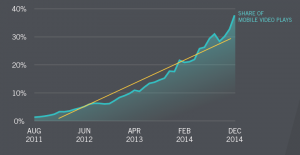— November 30, 2018

rawpixel / Pixabay
Six years into this business, and I’ve lost count of how many launches I’ve been a part of: either in the planning and strategy stages, as a copywriter, as an affiliate, and even doing my own launches.
And in that time, you can’t help but learn a few things.
‘Tis the season to be launching (now through January or February or so) and so I thought I’d share some of the biggest lessons I’ve learned about launching over the years:
1. It’s a numbers game.
This is maybe the most important lesson I’ve learned about launching, and one I wish I could impart to more beginning entrepreneurs. The success of your launch is alllll about the numbers.
If you go with industry-wide averages, only 1–3% of people who see your offer (ie: go through your launch and land on your sales page and get the follow up emails) will actually make a purchase. That 1–3% number is your sales goal. So if you want to make 50 sales, you need 5,000 people to go through your launch with you. (If you missed how to figure percentages like that in math, as I did, you can use percentagecaulculator.net to figure this out.)
If you’ve ever thrown a wedding or big party, people say to expect 50% of people you invite to actually come; you invite a lot more people than you actually expect to turn up. The same is true for your launch: you need exponentially more people to be invited to your launch than actually come to the party.
And that’s where content marketing, advertising, and affiliate promotions come in.
But Lacy, I hear someone in the back saying, couldn’t I have a better conversion rate than 1 percent?!?
Yes, absolutely. But until you have data and can PROVE to me that your conversion rate is better than average, it’s a good idea to stick with the average to figure your numbers. The worst that can happen is that you’ll sell a lot more than you expected!
2. It’s a lot more work than people want to talk about.
You don’t hear as much about “passive income” these days as you did when I first got into the Internet marketing game, but let me just tell you this: there is nothing passive about a launch with a start date and an end date. It is a hell of a lot of work.
(There may be an argument to be made for an evergreen funnel that is passive, but even then, you have to always be monitoring and tweaking the funnel.)
I used to think that launching a 1:many course would be a lot less work than trying to sell 1:1 services, and I was DEAD WRONG. Launching is maybe even MORE work than selling 1:1. Can it be profitable? Absolutely! But don’t let anyone sell you on the idea that it’s easier.
3. A good copywriter can make a big difference.
If you’re launching your first course or working on a really tight budget, I’m not going to try to convince you to hire a copywriter you can’t afford! Use a template, get a lot of feedback, and do your best: you’ll be fine, I promise.
But as you get more sophisticated and your launches get bigger, a skilled copywriter can increase your sales tremendously. Because we’ve studied how this work, we know which psychological buttons to push, and we’re thinking about things you haven’t even considered.
Because it’s our job, not because you suck or anything.
Seriously, we have a woman on our team who has increased people’s conversion rates from emails by double digits. That’s serious $ $ at the end of the day.
4. You don’t have to follow a launch “formula.”
There are a million marketers out there who want to sell you their idiot-proof, never-fail, six figure launch formula — and that’s fine. I’m sure most of them work, most of the time. (Assuming you’ve got the numbers at the top of the funnel to make it happen — see point No. 1.)
But the truth is, you don’t have to follow anybody’s formula in order to have a successful launch. I have colleagues and friends who have broken every rule in the book and still had five and six figure launches. I once sent a single email and made over $ 5,000 “launching” something new.
The point is, don’t get bogged down in trying to figure out the “right” way to launch your thing, or whether you can afford so-and-so’s course on how to launch your thing.
Just launch the thing. Then figure out what went well and do more of that.
5. One launch does not a pattern make.
Another big lesson I’ve learned is that just because something worked (or didn’t work) on your first launch doesn’t mean that it will continue to work (or not work) forever.
It’s important to remember that, for your first launch, you’re likely to reach the early adopters — the people who are excited to try new things. If you remember the customer awareness spectrum, you’re probably reaching the problem aware and aware of you customers with your first launch.
But after a couple of launches, those people are going to start to dry up. You may need to retool your launch content to bring people at earlier stages into the fold.
Or, you may run out of people at the top of your funnel. (NUMBERS again!) You may need to reach a new audience that hasn’t heard from you before.
The point is, what worked today may or may not work tomorrow. Every launch is an experiment, and you have to adjust accordingly.
6. You should *always* be thinking about launching.
OK, that’s a bold statement, but hear me out. In my world, all content marketing must be dedicated to achieving a goal. If you work on a launch model, your goal is almost certainly going to be MOAR LEADS.
All. The. Time.
That means, if you launch your big thing in July, you damn well better be focused on collecting and nurturing leads in January, April, September, and November.
Your content should always be working for you so that you have those big numbers when it comes time to launch and you’re not in a cold panic about how you’re going to get 30,000 people to see your offer in the next six weeks. (True client story.)
The cold hard truth is that if you don’t have money to spend on a massive ad campaign, then your alternative is to spend TIME building up your leads. Which means you have to always be thinking about how your content is going to feed that funnel — even if it’s just in the back of your mind.
7. Bonuses and discounts can work… or make you look desperate.
At some point it became de rigeur to offer a zillion crazy bonuses with your launch, that bring the “value” of the package up way higher than the pricetag. And sometimes that can work.
But sometimes it can make you look ridiculous and desperate.
For example, if you’re trying to convince me that an ebook you’re offering as a bonus is somehow worth $ 399 just to bump up the value of the package, I’m going to be giving you some serious side-eye. People know how much they usually pay for an ebook. Don’t be weird.
Whenever you offer a bonus or a discount, there should be a REASON attached to it. And no, “just because I’m launching” is not a good enough reason.
I like the “quick decision bonus” that people get for making a commitment within the first 24 or 48 hours. That rewards them for making a decision and helps boost your early numbers.
8. Affiliates only work if you do.
Affiliate marketing seems like such an awesome idea — you get other people to do the selling for you!
But the best affiliate programs work well because the creator (or creator’s team) is deeply involved with the affiliates. The creator writes sales copy, emails, tweets, Facebook posts; she makes herself available for webinars and live streams and interviews; she creates graphics and templates; and she is in CONSTANT communication with her affiliates during the launch to encourage them and support them.
It’s a BIG job.
The other thing to consider is that the typical affiliate payout is around 50% of the retail price. Unless your profit margins are redonkulously high, that’s a really big cut of the pie you’re planning to hand out. If a Facebook ad campaign cost 50% of the retail price, most people would shut that mother down so fast it would make your head spin!
So just be aware that affiliate marketing can work, but you’ve got to work hard and be prepared to pay out to see results.
9. Launching takes more time than you think.
I cannot tell you how many times a perfectly lovely entrepreneur has come to me and said they need help with their launch — which is happening in two weeks. And I cannot tell you how much I hate having to tell that perfectly lovely person that I cannot help them.
Content marketing is a LONG game. In an ideal world, you are planning how your content will support your launch all the time (see No. 6). In the real world, it takes a lot longer than most people think to “ramp up” to a launch.
For example, if we take our numbers from No. 1 and assume you want 50 sales, how long would it take you to get 5,000 people on your email list? I did about that in six months — using only free methods (no paid advertising). Your mileage may vary.
If you’re committed to a launch date and don’t have a way to get to that goal number in the amount of time you have, you’re going to have to adjust your sales expectations.
I used to say you needed a minimum of six weeks for a successful launch. Now I would say that you can launch in six weeks — if you already have all the leads you need. If you need more leads, you need more time (or more money to pay for ads). Simple as that.
And that’s without considering how much time it will take you to create all the collateral — not even the course itself, but the sales page, the emails, the videos, whatever content you’re going to lead with, etc. If you decide to work with a copywriter (see No. 3) she may be booked up or may need a longer lead time than you’re expecting. I would never expect to work with a copywriter and/or a designer for a sales page with less than a month lead time before launch — maybe more.
What about graphics? Photos? Testimonials? Affiliate collateral? Emails? The more involved your launch, the more time you need to prepare.
10. Internet famous people have a lot of help.
One of the worst things about our Internet marketing community is how easy and common it is to compare yourself to the big names out there.
Having been on the back end of some BIG name launches, I can tell you with absolute certainty that these Internet famous people have a LOT of help. Huge teams, launch managers, affiliate managers, sales page designers, customer support teams, videographers, photographers, copywriters — the list goes on and on.
So before you decide that you need a huge, three-video launch with 25 emails and 6 different customer segments, plus a dozen affiliates, remember that you may have less help than your mentors and idols.
And that it’s perfectly OK to scale back.
In fact…
11. The personal touch works really well.
Until you get so big that you’re selling hundreds or thousands of units with every launch (at which point it would be nearly impossible), try personalizing the experience as much as possible.
Track your best leads and send them personal emails. Offer to get on chat or the phone with people to answer questions. Invite people personally and individually and tell them why you think it would be a good fit for them.
The thing is, I think a lot of us are uncomfortable with that kind of “hand selling,” because we’re either uncomfortable tooting our own horn that much, or we’re afraid to be too “salesy.”
But the reality is that when you’re smaller and just starting out (or when you’re selling a very high ticket offer) this is absolutely the way to go. You’ll see much better success than trying to automate everything.
Business & Finance Articles on Business 2 Community
(46)
Report Post





